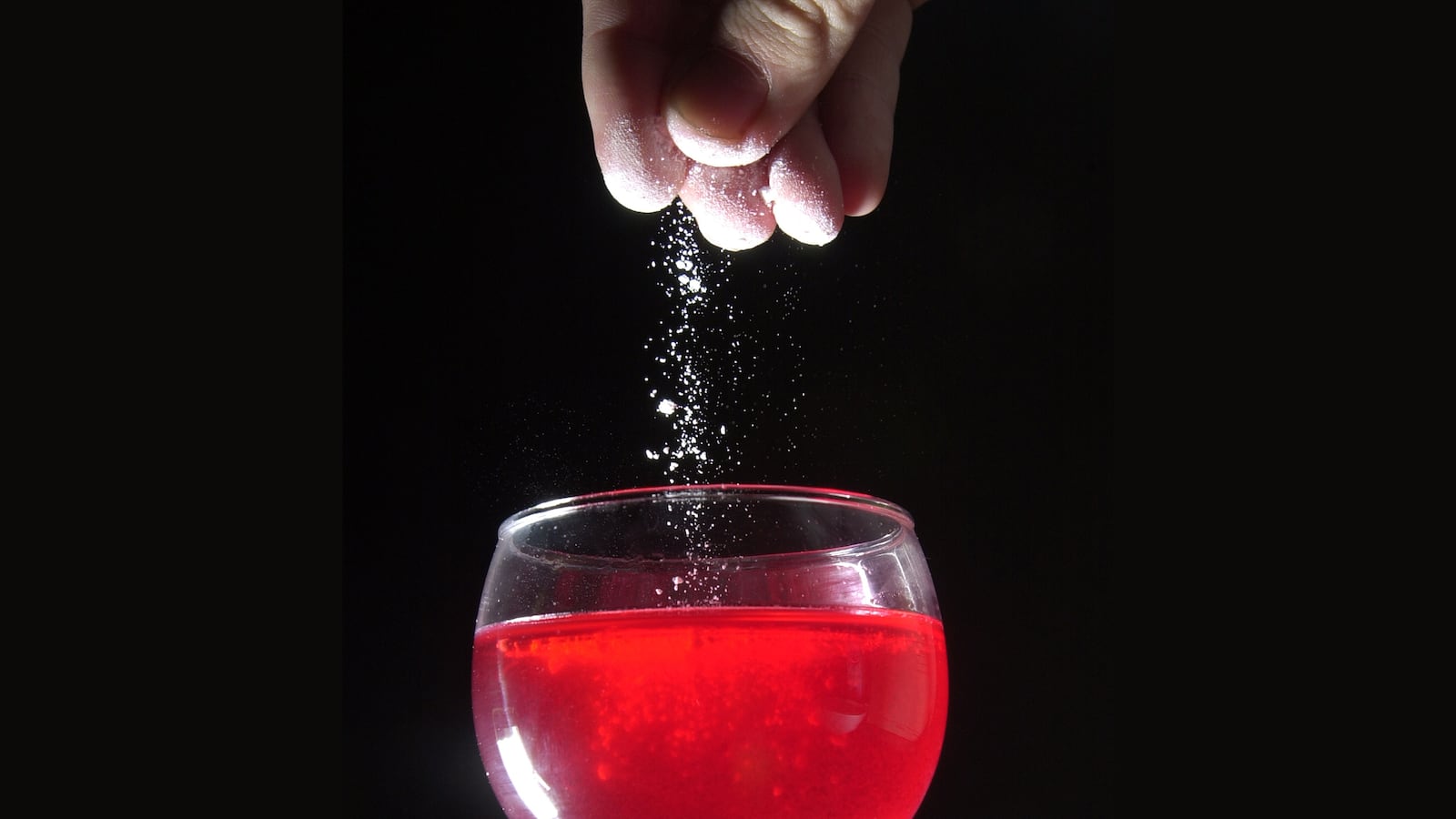When police stopped John Stamos for swerving through Beverly Hills in his silver Mercedes, the most surprising part of the celebrity’s DUI arrest was that he was charged with driving under the influence of “date rape drug” GHB. The central nervous system depressant is best known as a substance slipped into drinks to aid sexual assault, yet Uncle Jesse was reportedly taking it on purpose to “lean out” body mass before shooting his new TV show.
Among celebrity circles and fitness-conscious professionals who post on anonymous online forums and whisper to trainers at Gold’s Gym, GHB—or gamma-hydroxybutyric acid—is making a comeback.
It’s a drug with a bizarre back story. Depending on whom you ask, it’s either the perfect party drug—or pure evil. The substance, which is produced naturally in small amounts by the body, was used in 1960 as an anesthetic. In the late 1980s, the drug became popular among gym-goers and club kids.
Fans claim that GHB—often sold as Easy Lay, G, Georgia Home Boy, Goop, Grievous Bodily Harm, Liquid Ecstasy, Liquid X, and Scoop—provides the euphoria of alcohol without the sloppy side effects like slurred speech or hangover. Bodybuilders say that it increases production of human growth hormone (HGH) and promotes sounder sleep.
When users overdose, however, GHB can cause a coma-like sleep—and mixing it with alcohol the increases the depressant effect, quickly leading to unconsciousness. This led to the substance being labeled, along with Rohypnol (“roofies”), as the drug of choice for sexual predators. In 2001 the government listed GHB alongside heroin and LSD as a Schedule I substance, and popularity declined.
I was first offered a (then-legal) nail polish-sized vial of “Liquid X” in the mid-90s, when I was 14 and dating a popular 17-year-old athlete who maintained a 4.0 average in spite of his heavy partying habits. When he told me that the drug “burns fat, won’t give you a hangover, makes you want to have sex, and can’t get you busted for booze,” I was in.
But as he pressed the bottle of clear liquid into my palm, my date, like the wise Mr. Wing in Gremlins, laid out the three GHB rules: Don’t take it with strangers, don’t take too much, and NEVER mix it with alcohol. For a few weeks, GHB was a wonder drug. I could party all night, was less inhibited about hooking up, and maintained straight A’s on four hours of sleep.
According the Drug Enforcement Administration (DEA) fact sheet, the average GHB dose is 1 to 5 grams and takes effect in 15 to 30 minutes, depending on the dosage and purity of the drug. The DEA fact sheet also warns that GHB overdose can result in “seizures, slowed heart rate, greatly slowed breathing, lower body temperature, vomiting, nausea, coma, and death.”
But on the street, drug dealers don’t usually carry measuring spoons. So GHB doses are measured by the capful, at a cost of $5 to $30 each.
I became a real-life cautionary tale a few weeks later at a New Year’s Eve bash, when I drank a beer and took an extra capful of GHB when my regular dose stopped doing the trick. Four hours later, I woke up in a puddle of my own vomit and my concerned friends standing over me trying to find a heartbeat. Thankfully, they had thought to turn me on my side—GHB can inhibit the gag reflect, which can cause users to choke when trying to throw up.
That night, I discovered the razor-thin margin between being the life of the party on GHB and being dead. I never touched it again.
Even hardcore G-fans, including one online commuter who called the substance “a truly magical substance that changed my life,” warn that careful dose measuring is crucial. “With its small quantity there was no boundary on how much a person’s stomach could hold. Any idiot could swallow 10 caps of GHB and wake up in a hospital,” the user wrote on Bluelight. “Taking 10 shots of vodka in a row would be an accomplishment. Thus, the dark passenger of drug culture is revealed: a lack of self-discipline.”
“One gram of GHB can be like a can of beer, two grams can be like three cans, and three grams can be like a case,” Steven Fowkes, the controversial chemist and executive director of the Cognitive Enhancement Research Institute (CERI), told The Daily Beast. However, he believes that the culture that forces users to go underground and mix their own substances at home is the problem, and points out the “hypocrisy” of the FDA approving a GHB derivative, Xyrem, to treat narcolepsy while claiming that it is a dangerous drug on other fronts.
Fowkes, who presented a case to the California State Legislature in 1997 to keep GHB available, maintained that his solution would be to make the drug legal—and regulated. He added that GHB has a bad rap because on its own, it has no anesthetizing effect—it’s only when the drug is combined with something that does, like alcohol, which causes problems.
Sixteen thousand people have overdosed on GHB and 70 have died since 1990, according to data provided by the Substance Abuse and Mental Health Services Administration. This is, admittedly, a tiny number when compared with the 100,000 deaths reported annually by the Centers for Disease Control (CDC) due to alcohol—but many experts believe that, because GHB is often undetected, these may only be the tip of the iceberg.
In March, only a few weeks before BuzzFeed reported on the resurgence of the drug among emergency room doctors and gay clubbers in San Francisco, two people overdosed on GHB at a popular club in Park City, Utah. In July, the LAPD reported that one woman died and two were left in critical condition after they took the drug while partying at a Venice Beach house.
A recent New York University study that examined the connection between rave culture and drug use in high school seniors found that the use of illicit “club drugs” including GHB and ketamine were almost six times more prevalent among “teen ravers” than students who did not attend EDM events.
So why do ravers take the risk?
Not surprisingly, young clubbers who smuggle the liquid in water, Gatorade, or eye drop containers love the drug for the same reason as their older celeb counterparts: It’s very difficult for police to detect and leaves the blood within a few hours, making it ideal for those who have been through rehab, or face regular drug tests for other substances.
“I call it the Nick Nolte effect,” said former LAPD detective Trinka Porrata, who now runs ProjectGHB, a nonprofit focused on GHB addiction and recovery. Porrata was referring to the 2002 incident in which the actor was arrested while driving under the influence of GHB, which resulted in the now-infamous wild-haired mug shot. She explained that hospital emergency rooms do not have the technology to test for GHB on site, so they have to send out for additional lab work, which can be expensive and time- consuming. “They do it because no one, including judges, knows what GHB is. The system forces them into it,” she says.
Nolte spoke fondly about GHB binges is a recent interview with GQ. Stamos was released from the hospital the day after he was arrested. He then checked into a residential facility a few days later, where he successfully completed treatment.
Others find that it’s hard to quit once the party is over. The DEA reports that regular use of GHB can lead to addiction and “withdrawal that includes insomnia, anxiety, tremors, increased heart rate and blood pressure, and occasional psychotic thoughts.”
Porrata says that, in her experience dealing with addicts, GHB is “harder to quit than heroin.”
Former Mr. America Mike Scarcella died from GHB withdrawal in 2003, and after baseball star Mike Piazza’s friend and personal trainer Mike Fox shot himself while trying to give up GHB, his mother told the media that the drug is “evil.”
One of the Venice Beach victims warned reporters at the time that the drug that made her feel like a sexual superwoman quickly started to ruin her life. “It instantly made me feel completely euphoric, increased my sex drive; I just felt so at peace,” she said.
Before long, she admitted: "I was urinating myself. I passed out in the shower. I would wake up and not remember anything that happened.” She said that she wants her story out there in hopes people won’t even take that first sip.






